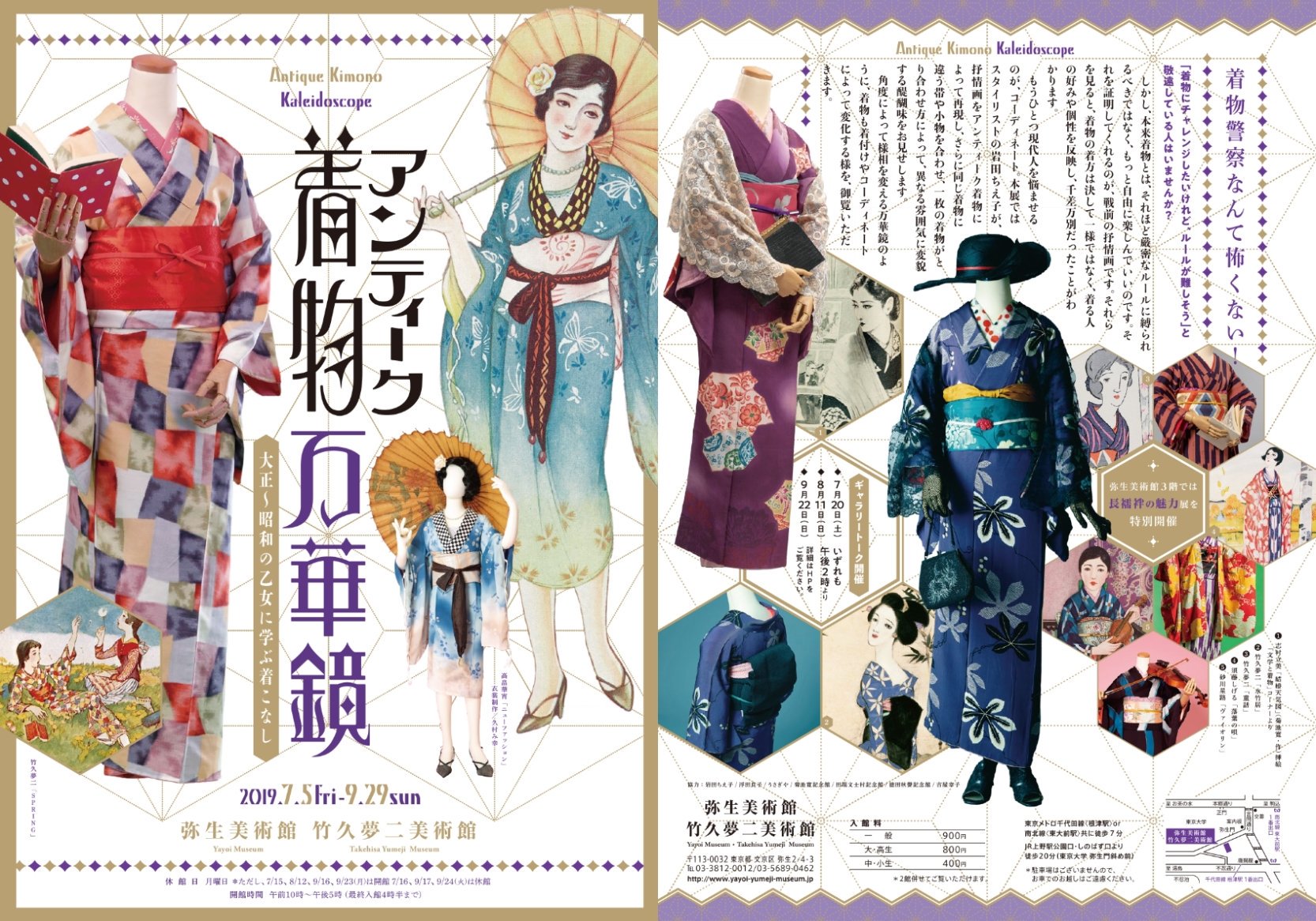「アンティーク着物 万華鏡」Antique Kimono Kaleidoscope
With the stylist, Ms. Chieko Iwata
協力 岩田ちえ子さんと共に
A new exhibition has opened its doors at the Yayoi-Yumeji Museum in Tokyo.
If you are a lover of antique kimono or even art and history, the new “Antique Kimono Kaleidoscope” collection is a real sight. Styled by no one less than Chieko Iwata, the kimono stylist who also worked closely with Nobuyoshi Araki (yes, that Araki!) over decades.
皆さん、いかがお過ごしですか? まだ雨の多い日が続いてますね。洗濯物がたまってたまって、たまに晴れた日は洗濯を2,3回なんてことも。これを梅雨の洗濯地獄といふ。
さて、そんなジメジメな気持ちを吹き飛ばす展覧会に行ってまいりました。
東京都文京区の弥生美術館と竹久夢二美術館で行われている「アンティーク着物 万華鏡 ―大正~昭和の乙女に学ぶ着こなし―」展覧会です。アンティーク着物や芸術、歴史が好きな人に最高です。今回、この展覧会の協力を勤めてくださったのは岩田ちえ子さんです。キューレターは学芸員の中村圭子さんと中川春香さんです。
実は岩田さんは、荒木経惟さん(ナ、ナ、ナント、あの世界の「アラーキー」!です)と長年にわたってお仕事をされてきました。海外の人でもアラーキーさんを知っている方は多いです。あの方の作品に着物が登場することがしばしばあり、その着物は岩田さんがあつらえたものだそうです。後半では、岩田さんへのミニインタビューも掲載してますよ。

What makes me very happy on a personal level, is the theme of this collection:
今回のテーマは、わたしにどハマリなんです。
No need to be afraid of the “Kimono Police”
着物警察なんて怖くない!!
If you are hearing of the “kimono police” for the first time, let me quickly explain: When you wear a kimono, sometimes you may meet a person (often a “lady”) who tells you, that this or that detail of your outfit or dressing is not correct by the “kimono rule book”. We call these people the “kimono police” as they try to enforce some kimono rules on us.
Do not get me wrong. The “Kimono police” are basically kind people who try to teach us how to wear kimono (not everyone is that nice!) out of their goodwill, I am sure! But some may find it discomforting because sometimes we wear kimono in our style deliberately even though we know the “traditional rules” more or less.
「着物警察」って聞いたことあります?(本来の着物の決まりに基づいて)着物を着てオモテに出るとき、「ここが違う、ここをこうする」ってわざわざ教えてくださる方のことをいいます。英語で(勝手に 汗)キモノポリスと呼んでますが、なんかかっこいいですね。ロボコップみたい 笑。 誤解がないように言いますが、着物警察は悪い人ではまったくないんです。皆さん、決まりを勉強された方は教えてあげたいと思ってくれるんです。
着物について勉強不足な私には、着物の専門家の人からはツっ込みたくなる箇所(フリ)も多々あることは十分承知です。ただ、自分で勉強してきた中で、決まりとは違うと知っていながら、自分なりに着崩しているところもあったりするわけです。また、興味本位で軽く着物を見よう見真似で一生懸命着てみて、町へでると、ここは違うとか、指摘されたり、直されてしまうと、親切に教えてくださっていると十分わかりながらも、ココロが折れたりしちゃう人もいるわけです。
The rather strict kimono dressing as we know today actually does not go that far back. The dressing was introduced when kimono started to become a piece of formal dress for special occasions.
In fact, Japanese kimono have been casual daily wear clothing for hundreds and hundreds of years. They have been worn in a sloppy way, tied out of the way with a tie and got dirty – as clothing does when you live and work in it.
現在のキモノって、決まりごとが沢山ありますが、これは、キモノが正装としての地位を確立する過程でのことで、日本のみーんながキモノを着ていたキモノ=普段着の何百年間は、みなさん、かなり自由に着ていたようです。

Enjoying life carelessly in kimono 「キモノに自由を!」なんちゃって 笑 
With my friend Sato (@sato_kimono) 友達のさとちゃんと♡ Look at how she dressed herself in the style of this exhibit お友達さとちゃんと、展覧会のテーマにあわせてのコーデです!
The Antique Kimono Kaleidoscope exhibition wants to remind of times where kimono wearing was carefree and personal. Based on lovely artworks from the Meiji (1868 – 1912) & Taisho (1912 – 1926) era, Chieko Iwata styled lovely kimono outfits which look like they just jumped out out of the drawing itself.
展覧会「アンティーク着物 万華鏡」は、この国の人々が着物を自由に個性的に着ていた時代を垣間見る機会となります。明治(1868-1912)と大正時代(1921-1926)の絵画、イラストなどをベースに、岩田さんは実際の着物をスタイリングされています。展覧会で、先ず、みんなびっくりすると思うんですが、岩田さんのコーデされたお着物たちはまるで、元になる絵画からそのまま飛び出してきたかのようなんです!!

Taken under a special permission. Photo not allowed. 特別に許可を頂いて撮影しております。館内の写真は基本的に撮影はできません(スミマセン!)

Wall screen showing elegant ladies’ attire changing from Meiji to Showa era 明治から昭和へのファッションの変遷が描かれた屏風 
Kimono with western elements like in the left corner started in the Meiji era 西洋的な要素を取り入れた着物(左端)は明治時代から始まったようです
The museum itself consists of 3 floors and two connected buildings. Each floor offering a different experience including a corner where you can touch different silk kimono and and take pictures. This collocation also offers some explanation in English.
今回の展示場所は、三階建てで、弥生美術館と竹久夢二美術館の建物からなります。それぞれの階で異なる体験ができるんです。例えば、異なる正絹の着物をさわり、写真を撮ることもできる場所もあります。英語での説明もあるので、日本語が分からなくてもモーマンタイ(古)!

Kimono as everyday clothing. Nobody would dare to cry into their sleeve today. 
Western clothing with a Haori jacket on top. Based on the old drawings in the back.
Nagajuban – another layer of art below the kimono
長襦袢(ながじゅばん) キモノの下にあるもう一つの芸術
On the top floor you can learn about and also try on some antique Nagajuban – the “under kimono” worn below the actual kimono.
最上階では、何着かのアンティークの長襦袢を試着でき、キモノの下の「着物の下着」について知見を深めることができるんです。

The Nagajuban – today mostly white or pink – used to be a real fashion statement. Whilst we are taught today to not have our juban peeking out, it used to be part of the outfit in the past. They were a piece of art, dyed in vivid red or with colorful designs. (See picture above – can you see the red undergarment? Also take note of how loosely they were dressed.)
How fun is that?
現代のキモノの決まりでいえば、長襦袢は白かピンクが普通ですが、昔は、お洒落の一つだったんですって。今ですと、着物の間から長襦袢は見えてはいけないのが、普通のルールですが、昔は、アートの一つで、鮮やかな赤色や様々なデザインで染められていたんですって。
上の写真を見てください。長襦袢が裾から見えたりしてます。とてもきれいなデザインですよね。

Famous woodblock print by Takehisa Yumeji 竹久夢二さんの木版画 
Styling based on the art 左の作品をベースにしたスタイリングです
Taken under a special permission. Photo not allowed. 特別に許可を頂いて撮影しております。館内の写真は基本的に撮影はできません(スミマセン!)
One of my personal favorite is this work! A woman venturing outside, trying to shield herself from the snowfall by Takehisa Yumeji (竹久夢二). If looking closely you can see all the layers keeping her warm. How rough the kimono is tied, almost sliding off her shoulder, the obi soft like a shawl wrapped around her waist. Also here the under-kimono is showing here and there and the kimono is tied with a shibori tie in front.
So happy to have this beautiful art piece come to live in this exhibition. This is how I want to wear kimono – like a piece of clothing that lives!
なかでも最も目をひいた作品の一つが、 竹久夢二さん作の雪の中に立つ女性です。よく見ますと、寒さの中、何枚も重ね着しているのが見えますね。着物の着付けも、完璧とはいえません。帯は柔らかいショールのようで、長襦袢も見え隠れしています。わたしもこんなスタイリングができたらいいなぁ~。

Mini interview with Ms. Iwata
岩田ちえ子さんへのミニインタビュー
For this visit I was lucky enough to be introduced to the stylist Chieko Iwata, by my friend Sato-san. Chieko is such a fun person, who actually took the time to tour the exhibition with us. I took the chance to ask a few questions, which I’d like to share with you.
今回、お友達のさとちゃんの紹介で、展覧会の協力でありスタイリストの岩田ちえ子さんにお話を伺うことができました(ありがとう、さとちゃん!!)。岩田さん直々に展覧会を回っていただきました。
Can you believe she curated and styled the whole exhibition in only two months? The artwork was provided by the museum but basically all kimono displayed are actually from her own collection!
岩田さんは、今回の展覧会の二ヶ月前という短い期間で、協力とスタイリングを準備したんですって。作品は、美術館側からの提供ですが、展示されている全ての着物は基本的に岩田さんのコレクションだそうです。わたしなんて足元にも及びません。スゴ過ぎる!
When asked if she is also wearing kimono herself, she denied and explained that she loves to style others and wouldn’t know where to start with herself.
Another reason is that she studied how to dress others, but is not used to dressing herself.
着物はよく着られますか?という質問には、ご自身では着ないそうです。理由は、自分以外の人に着物スタイリングをすることが大好きで、自分で着るのはどこから始めていいか分からないからだそうです。もう一つの理由は、他人に着付けすることを極めてきたので、自分で着ることに慣れていないんだそうです。
Before getting into kimono styling, she was working at a PR company. Once day they had to shoot a commercial for a kimono company, so the staff asked her to learn how to fold kimono. After watching and learning things on the job, she thought it was very interesting and started taking lessons to perfect her skills. Shortly after she got introduced to the famous photographer Araki, who was already picked up by the first photography magazines at the time. Chieko was hooked by Araki’s art as she never got bored with the work she was doing.
A truly exceptional lady with a refreshing view on the traditional garment that is kimono.
Talking to her truly inspired me to try thinking more outside the box.
岩田さんは、着物スタイリングを始める前は、PR会社に勤務されていたそうです。着物会社のCM撮影の際、岩田さんが着物を畳むことを任され、そこから、仕事を通じて見て学び、着物についてとても強い興味を覚え、着物レッスンを受け、鍛錬されたんだそうです。荒木さんに紹介された後間もなく、当時、有名な写真誌が岩田さんをピックアップしていたとのことです。荒木さんの作品の魅力に引き込まれ、つまらないと思ったことは一度もないといいます。
伝統的な着物について、斬新な見方をされている岩田さん。お話して、わたしも、もっともっと創造的になってもいいと感銘を受けました。

Thank you so much for taking so much time! I am truly delighted to have made your acquaintance ♡
岩田さん、今回はお時間ありがとうございました。とても素敵な方でしたよ。さとちゃん、ご紹介、有難う!今回のご縁に感謝です。色々と一緒になにかできるといいなぁ。
By the way, if you are in need for a refreshment during your visit: The Café of the museum offers special drinks during this exhibition. The purple actually changes its colour when adding sugar. (If you are just plain hungry, they also have Japanese curry and other savory delights.)
さて、暑い夏も近くなる今日この頃。美術館へいったら、ぜひ試してほしいのは、併設されてる喫茶店です。今回の展覧会の特別なドリンクがあるんです。砂糖を加えると色がかわります(ネタばれしてもうてるやん 笑) おなかがすいたらカレーなどもあるので是非!

限定のドリンク 
写真はアングルが微妙でスマソw
If interested you can also get the book of the collection (Japanese) in the museum shop or via Amazon.
岩田さんは、今回の展覧会のテーマで本も綴られてます。美術館またはアマゾンから購入できますよ。
The exhibition will be open until the 29th of September 2019.
2019年7月5日(金)から9月29日(日)までやっています。みんなもぜひ訪問してみてくださいね。また、感想も教えてね!
Yayoi Yumeji Museum Tokyo / 弥生美術館&竹久夢二美術館
http://www.yayoi-yumeji-museum.jp/index.html
Open: 10 AM to 5 PM (Please enter by 4:30 pm) / 午前10時~午後5時(入館は4時30分までにお願いします)
Closed: Mondays (or the following day when Monday is a holiday) / 休館日:月曜日(祝日の場合は翌火曜日)
Entrance Fee: Adults: 900yen / 入館料:一般900円/大・高生800円/中・小生400円
Address: 2-4-3 Yayoi, Bunkyo-ku, Tokyo 113-0032 / 〒113-0032 東京都文京区弥生2-4-3
Tel:03-3812-0012









































